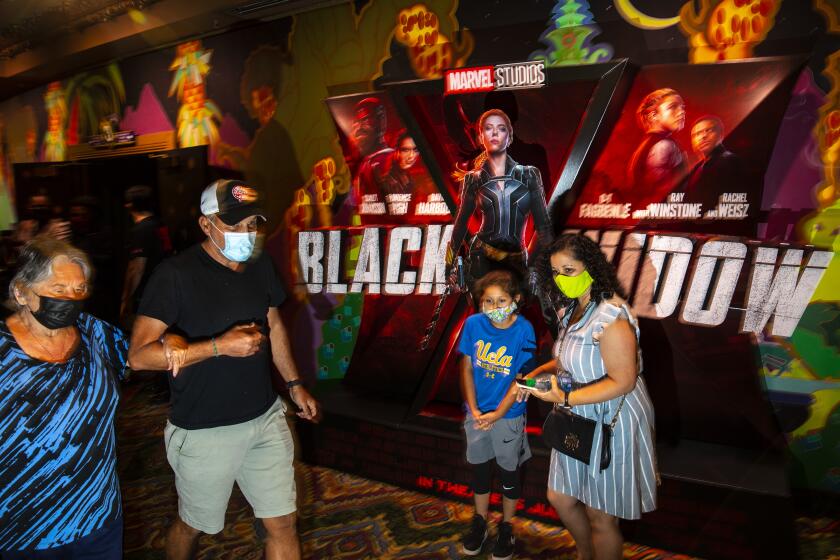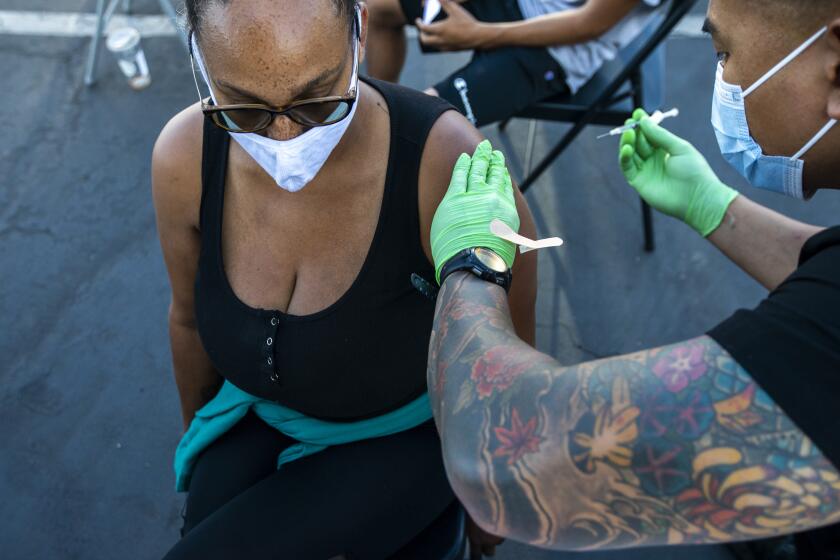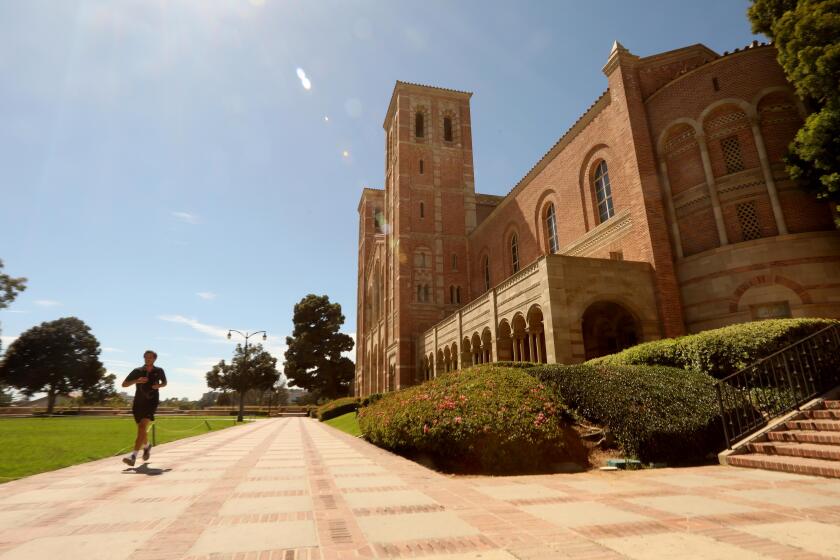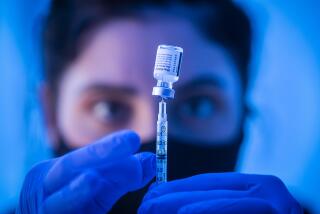With new mask rules, L.A. County is asking the vaccinated to help the unvaccinated

- Share via
Los Angeles County’s rise in coronavirus cases over the last two weeks poses a unique challenge.
About 99% of the people getting sick are unvaccinated. Those who have gotten their shots are protected and can get back to normal life after more than a year of pandemic shutdowns.
Officials have been desperately trying to convince those who have not gotten their shots to do so. But with limited success.
So the county is now requiring everyone — vaccinated and unvaccinated — to wear masks inside public places.
The vaccines are believed to be essentially as effective against the Delta variant as other variants. And so those who got their shots don’t need a mask to protect themselves.
Faced with a rise in coronavirus cases, L.A. County will again require residents to mask up in indoor public spaces — regardless of vaccination status.
But officials suspect that unvaccinated people have also stopped wearing masks in indoor public settings and businesses, even though they’re still required to do so.
So vaccinated people are being asked to make a sacrifice to help slow coronavirus spread among the unvaccinated.
Times data show that 51.8% of all Californians are fully vaccinated to date, though wide regional gaps persist. In San Diego County it’s 57%, in Orange County 54.7%, and in L.A. County 52.2%. The rates are much lower in Riverside County (42.1%) and San Bernardino County (39.2%)
Where does L.A. County stand?
Community transmission has accelerated dramatically in L.A. County since California fully reopened on June 15. At that time, the county was averaging 173 new coronavirus cases a day. For the seven-day period that ended Wednesday, the county’s average was 1,077 new cases a day. On Thursday, the county reported 1,537 additional cases.
Countywide, COVID-19 hospitalizations increased over that same period — from 223 on June 15 to 452 as of Wednesday. Still, cases and hospitalizations are more than 93% below what they were at the peak of the winter surge. And deaths remain at historically low levels, averaging about seven a day.
Although officials don’t expect hospitals to ever be as stressed with COVID-19 patients as they were during the winter surge, the healthcare system could still be significantly affected if trends continue.
“There is still time to take action and protect people through vaccination, since we are starting from a lower baseline rate,” Dr. Roger Lewis, who directed COVID-19 hospital demand modeling for the L.A. County Department of Health Services, wrote in an email. “It is critically important that everyone eligible for vaccination who has not already been vaccinated does so as quickly as possible.”
How does L.A. compare to other areas?
The county’s latest order is at odds with both the California Department of Public Health and the U.S. Centers for Disease Control and Prevention — both of which continue to maintain that vaccinated people need not cover their faces indoors — and also puts officials in the precarious position of asking the inoculated to forfeit one of the benefits recently enjoyed.
Tuesday marked the fifth straight day that the number of new coronavirus infections exceeded 1,000.
L.A. County got some pushback last month when it recommended mask wearing for everyone indoors. But some other counties are now following suit, and the California Department of Public Health said it “supports local health departments, like Los Angeles County, making stricter policies based on the conditions in their community.”
A cadre of Bay Area health officials — representing Alameda, Contra Costa, Marin, San Francisco, San Mateo, Santa Clara and Sonoma counties, as well as the city of Berkeley — also issued a recommendation Friday that everyone wear masks indoors while in public places.
Doing so would be “an extra precautionary measure for those who are fully vaccinated” and “ensure easy verification that all unvaccinated people are masked in those settings,” officials wrote in a joint statement.
When does it take effect?
The new health order goes into effect at 11:59 p.m. Saturday.
Long Beach, which has its own public health department, will align with L.A. County’s order. Pasadena, which also has its own health department, already recommends that everyone — including the fully vaccinated — wear masks in indoor public settings, and the city is “reviewing options for a mandate,” according to a spokeswoman.
What is covered?
Public indoor spaces such as theaters, stores, public venues and shopping malls. The mask rules will essentially revert back to where they were before the county lifted them before the June 15 reopening. At that time, some retailers dropped their mask rules.
What about indoor dining?
The order will continue to allow indoor restaurant dining, but it requires people to keep their masks on while they order and while waiting for food.
Does the order reduce business capacity?
No. The order does not require a reduction in business capacity or a return to mandatory physical distancing.
What other options are available to get people vaccinated?
One strategy to boost vaccine coverage could involve requirements to get inoculated, such as at workplaces.
Employers also could require unvaccinated workers to get tested daily — an approach used elsewhere,
The University of California announced Thursday that COVID-19 vaccinations will be required before the fall term begins for all students, faculty and others, becoming the nation’s largest public university system to mandate the vaccines even though they don’t have full federal approval.
The UC requirement underscores the uncertainty over campus health protocols as the Delta variant spreads.
San Francisco has been a leader in imposing vaccination requirements for some. Already, the city has ordered all workers in “high-risk settings” — such as hospitals, nursing homes and residential facilities for older people, homeless shelters and jails — to be fully vaccinated by Sept. 15. An exemption will be available for workers with valid religious and medical reasons, and they will be required to get tested for the coronavirus weekly.
Some public health experts have said effective approaches for persuading people to get vaccinated include answering questions and making the vaccine even more available to those who may not have prioritized getting the shot, either because they don’t think COVID-19 is a threat to them or because of swirling misinformation surrounding the shots.
“Relationships really matter,” said Dr. Christina Ghaly, L.A. County’s director of health services. Giving people “an opportunity to ask their questions, to get fact-based information about the vaccine, to be given a chance to just talk through their concerns” is an effective approach, she added.
“One-on-one conversations — it’s very labor intensive, not always very fast, it takes time,” she said. “But that’s been the best thing that has really helped.”
More to Read
Sign up for Essential California
The most important California stories and recommendations in your inbox every morning.
You may occasionally receive promotional content from the Los Angeles Times.















